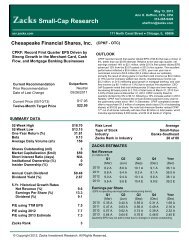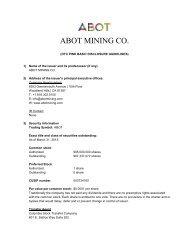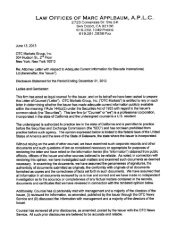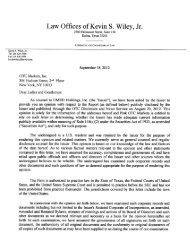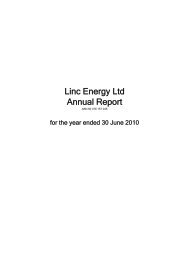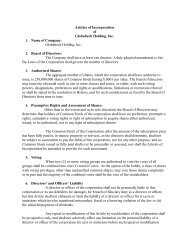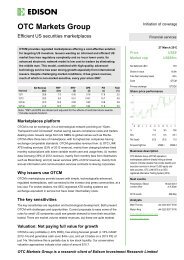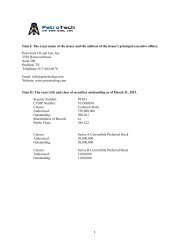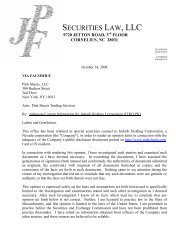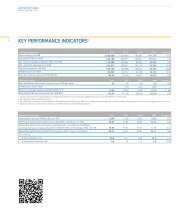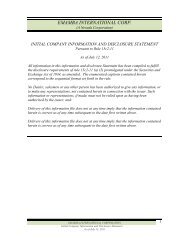2011 Annual Report - OTCIQ.com
2011 Annual Report - OTCIQ.com
2011 Annual Report - OTCIQ.com
You also want an ePaper? Increase the reach of your titles
YUMPU automatically turns print PDFs into web optimized ePapers that Google loves.
88 Notes<br />
cash equivalents acquired (disposed of) under investing activities<br />
if the respective acquisition or disposal results in a gain<br />
or loss of control. In the case of acquisitions and disposals that<br />
do not, respectively, result in a gain or loss of control, the corresponding<br />
cash flows are reported under financing activities.<br />
The impact on cash and cash equivalents of valuation changes<br />
due to exchange rate fluctuations is disclosed separately.<br />
Segment Information<br />
In accordance with the so-called management approach<br />
required by IFRS 8, the internal reporting organization used by<br />
management for making decisions on operating matters is<br />
used to identify the Company’s reportable segments. The internal<br />
performance measure used as the segment result is earnings<br />
before interest, taxes, depreciation and amortization<br />
(“EBITDA”) adjusted to exclude certain extraordinary effects<br />
(see Note 33).<br />
Structure of the Consolidated Balance Sheets and<br />
Statements of In<strong>com</strong>e<br />
In accordance with IAS 1, “Presentation of Financial Statements”<br />
(“IAS 1”), the Consolidated Balance Sheets have been prepared<br />
using a classified balance sheet structure. Assets that will be<br />
realized within twelve months of the reporting date, as well<br />
as liabilities that are due to be settled within one year of the<br />
reporting date are generally classified as current.<br />
The Consolidated Statements of In<strong>com</strong>e are classified using<br />
the nature of expense method, which is also applied for<br />
internal purposes.<br />
Capital Structure Management<br />
E.ON uses the debt factor as the measure for the management<br />
of its capital structure. The debt factor is defined as the ratio<br />
of economic net debt to our EBITDA. Economic net debt supplements<br />
net financial position with provisions for pensions and<br />
asset retirement obligations, as well as the net market values<br />
of currency derivatives from financial trans actions (not including<br />
transactions relating to E.ON’s operating business and asset<br />
management). The medium-term target set by E.ON for its<br />
debt factor is a value of less than 3, based on E. ON’s target<br />
rating of solid single A.<br />
Based on our EBITDA in <strong>2011</strong> of €9,293 million (2010: €13,346 million)<br />
and economic net debt of €36,385 million as of the balance<br />
sheet date (2010: €37,701 million), the debt factor is 3.9<br />
(2010: 2.8). Adjusted for the mostly non-cash non-recurring<br />
effects from the early nuclear power exit, the debt factor as<br />
of year-end <strong>2011</strong> is 3.4.<br />
Critical Accounting Estimates and Assumptions;<br />
Critical Judgments in the Application of Accounting<br />
Policies<br />
The preparation of the Consolidated Financial Statements<br />
requires management to make estimates and assumptions<br />
that may influence the application of accounting principles<br />
within the Group and affect the measurement and presentation<br />
of reported figures. Estimates are based on past experience<br />
and on additional knowledge obtained on transactions to<br />
be reported. Actual amounts may differ from these estimates.<br />
The estimates and underlying assumptions are reviewed on<br />
an ongoing basis. Adjustments to accounting estimates are<br />
recognized in the period in which the estimate is revised if the<br />
change affects only that period, or in the period of the revision<br />
and subsequent periods if both current and future periods<br />
are affected.<br />
Estimates are particularly necessary for the measurement of<br />
the value of property, plant and equipment and of intangible<br />
assets, especially in connection with purchase price allocations,<br />
the recognition and measurement of deferred tax assets,<br />
the accounting treatment of provisions for pensions and miscellaneous<br />
provisions, for impairment testing in accordance<br />
with IAS 36, as well as for the determination of the fair value<br />
of certain financial instruments.<br />
The underlying principles used for estimates in each of the<br />
relevant topics are outlined in the respective sections.



